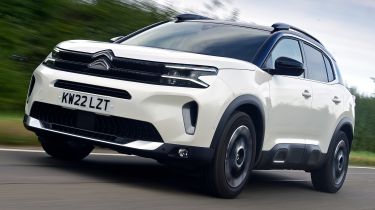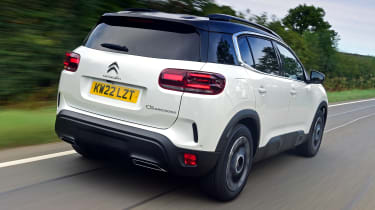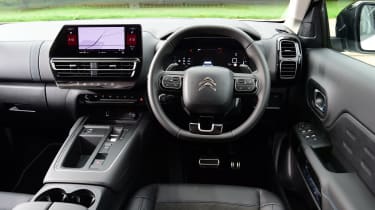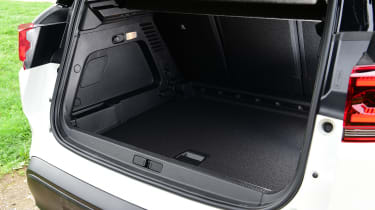New Citroen C5 Aircross 2022 review
On the whole, the C5 Aircross remains a practical, comfort-focused offering, now with an improved cabin ambience
Verdict
Save for a few cosmetic tweaks, there’s not a vast amount new with the revised C5 Aircross. We’re very pleased that Citroen has stuck to its guns with its focus on comfort above all else, making this a relaxing and practical family SUV. However, the infotainment tech is still a bit of a let-down, and the auto box is best avoided.
It really feels like Citroen has started to find its sense of direction in recent years. In the previous decades, there have been flashes of the daring quirkiness that singles out the brand’s past icons, but for the most part the company hasn’t offered any big selling points across its range to set its cars apart from their rivals.
The C5 Aircross was one of the first in the current Citroen range to show signs of that changing. A focus on space and comfort while other car makers pushed for a sportier driving experience and menacing styling made the brand’s big SUV a breath of fresh air when it came out in 2017.
Five years on, there’s a facelifted version – and we’ve now sampled it in the UK.
The revisions for 2022 start with a new look inspired by the recently released C5 X. The focal point is the revised front end, which gets new headlights that sit in a higher position. They feature split LED daytime running lights, which blend neatly into the central grille panel. Beneath this, there’s a tweaked bumper with new air intakes and a skid plate on the lower edge of the front bumper to emphasise the SUV look.
More reviews
Car group tests
In-depth reviews
Long-term tests
- Citroen C5 Aircross Max long-term test: SUV is a bit too exposed to the elements
- Citroen C5 Aircross PHEV: long-term test review
Road tests
- New Citroen C5 Aircross Hybrid 136 review
- New Citroen C5 Aircross PHEV 2022 review
- New Citroen C5 Aircross hybrid 2020 review
Used car tests
The flanks still get the distinctive “air bump” plastic cladding - originally conceived to protect the paintwork from low-speed dings, while reprofiled tail-lights round off the changes at the back.
Inside, the dashboard has been overhauled. At its centre, there’s a new, larger infotainment screen - although the new set-up looks as if it’s been simply grafted onto the existing fixtures of the pre-facelift model, which had a more distinctive air-vent arrangement around the display. While the 10-inch screen’s display is much sharper than the old hardware, it still runs very similar software.
In other words, the climate controls - in a break from other recent Citroens, there are no physical buttons here - are a permanent fixture on the screen, which robs a big portion of that display that could be put to better use showing a larger map or smartphone app. It’d be easier to use if it was angled ever so slightly towards the driver, too.
Elsewhere, the cabin is much the same as before. Passenger space in the back is competitive with rivals like the Skoda Karoq, but the C5 brings the added benefit of not only a third individual seat - instead of the raised bench section you get in most rivals - but individually sliding seats, too. With the seats pushed all the way back, there’s a generous 580-litre boot, but sacrifice some rear legroom and that figure grows to as much as a vast 720 litres.
As before, Citroen's fantastic Advanced Comfort seats are squishy yet supportive in all the right places, and they work in harmony with the chassis set-up.
Not much has changed under the skin, but in many ways, we’re glad it hasn’t. In terms of ride comfort, the Aircross ranks right towards the top of the class. There’s a system Citroen calls Progressive Hydraulic Cushions that helps here. Regular bump stops on the suspension are ditched in favour of secondary dampers, which cushion the blow from knocks if the coil springs reach the end of their travel. That allows those springs to be softer, and the result is a very forgiving ride, especially when cruising at motorway speeds.
This approach does mean that the C5 Aircross’s body rolls through the corners more than many alternatives. But if you want something engaging to drive, then a family SUV isn’t really the place to be looking for that anyway.
We’re driving the 1.2-litre PureTech turbo petrol here. The 129bhp unit is the entry point to a range that also includes a 1.5-litre diesel (with an identical 129bhp) and a plug-in hybrid model, which offers a pure-electric range of 33 miles and a total output of 222bhp when the electric motor combines with a 1.6-litre turbocharged petrol unit.
For most buyers, the 1.2-litre unit will be just fine. It’s a little short of power compared with the 1.5-litre TSI units you get in the Volkswagen group rivals like the VW Tiguan, the SEAT Ateca and the previously mentioned Karoq, but it pulls keenly enough from low revs and offers decent refinement. An almost complete lack of engine braking is an odd quirk, though.
Unless you really need an auto, we’d save £2,075 and plump for the six-speed manual instead. The eight-speed gearbox is controlled by a new selector on the dash, but its calibration with the stop/start system and brakes make it near-impossible to drive smoothly at low speeds.
The revised C5 Aircross starts from £28,070, which represents a small increase over the outgoing model. Kit levels in the base Sense Plus trim are still generous, though; 18-inch alloy wheels, a 12.3-inch digital instrument cluster, dual-zone climate control and satellite navigation are all standard. Shine trim adds roof bars and a reversing camera, while the top-spec C-Series Edition gets 19-inch wheels, a panoramic sunroof and a hands-free tailgate.
| Model: |
Citroen C5 Aircross Shine PureTech auto |
| Price: | £30,155 |
| Engine: |
1.2 3cyl petrol turbo |
| Power/torque: | 129bhp/230Nm |
| Transmission: |
Eight-speed auto, front-wheel drive |
| 0-62mph: | 10.3 seconds |
| Top speed: | 117 mph |
| Economy: | 38.6-46.7mpg |
| CO2: | 148g/km |
| On sale: | Now |
Now read our list of the best mid-size SUVs...








